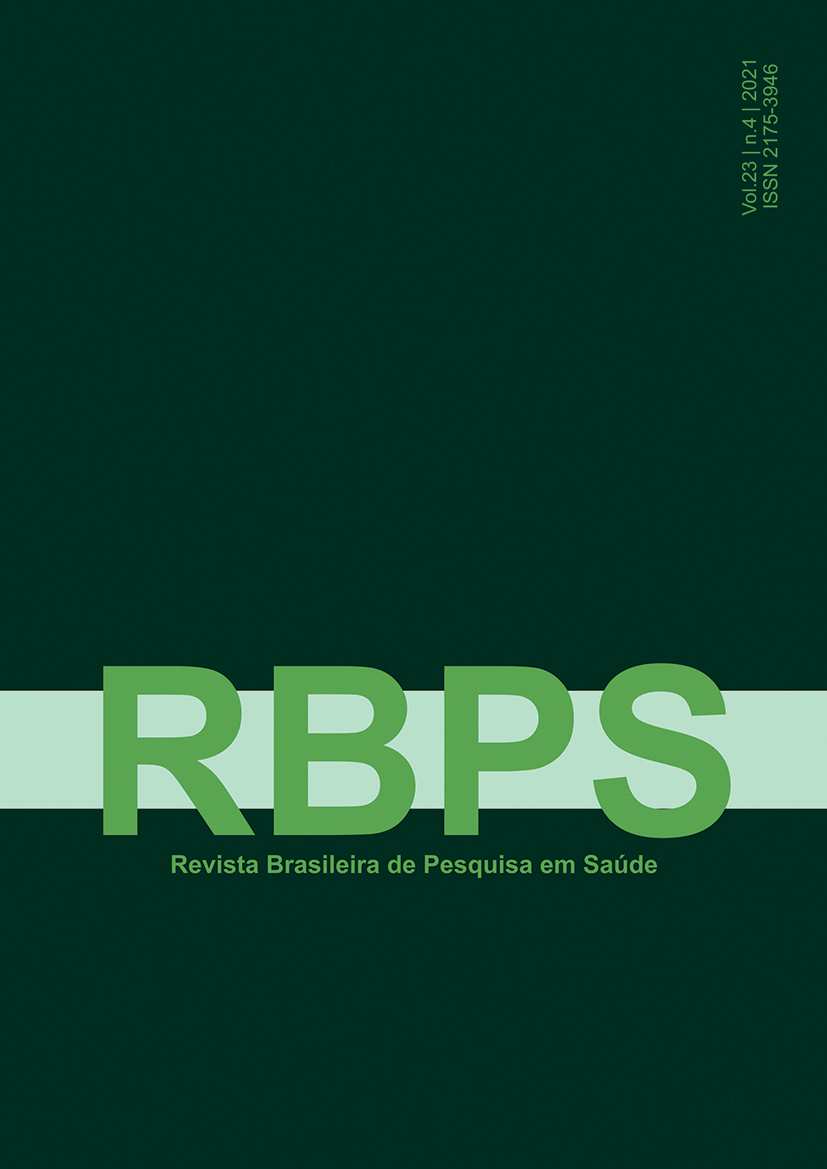Voice of the hearing impaired of cochlear implant users: integrative review
DOI:
https://doi.org/10.47456/rbps.v23i4.38496Keywords:
Voice, Cochlear implantation, Hearing lossAbstract
Introduction: The cochlear implant (CI) provides better conditions for the development and maintenance of hearing, providing auditory feedback during phonation and speech. Objectives: To analyze recent publications on vocal production of the hearing impaired user of CI. Methods: Integrative literature review, by searching the SciELO and PubMed databases. Articles published in English or Portuguese, from 2016 to 2020, whose titles included the words “voice” and “cochlear implant” and mentioned the relationship between CI and vocal production were included. Editorials, systematic reviews of the literature, those that related the CI with vocal perception or speech production in isolation were excluded. Results: 10 studies were selected that evaluated the voices of children, adults and alderly users of CI through: 1) Objective evaluation - acoustic analysis; 2) Subjective evaluations - from the patient himself (vocal self-assessment questionnaires), from speech therapist judges (Auditory Perceptual Assessment) and from other individuals (identification of vocal emotions); 3) Evaluation of physiological data - aerodynamic vocal analysis. Studies report progressive improvement in fundamental frequency, jitter, subglottic pressure and maximum phonation time after surgery and use of CI and speech therapy. There was a decrease in the general degree of vocal deviation, instability, degree of alteration in resonance, improvement in speech intelligibility and prosodic cues. Self-assessment revealed deviated symptoms and vocal handicap and improved quality of life 6 months after surgery. Conclusion: The auditory feedback provided by CI and rehabilitation therapies improves communication and reflects positive effects on the quality of life and voice of users.
Downloads
References
Souza LBR. Diferenças entre parâmetros vocais em crianças usuárias de implante coclear e em crianças usuárias de aparelho de amplificação sonora individual. Rev. CEFAC. 2013 mai-jun; 15(3):616-621.
Fabron EMG, Garcia YS, Pinheiro EMCD. A voz do deficiente auditivo: revisão bibliográfica. Distúrb Comun. 2017 março; 29(1):55-67.
Prado AC. Principais características da produção vocal do Deficiente auditivo. Rev CEFAC. 2007 jul-set; 9(3):404-10.
Botelho LLR, Cunha CCA, Macedo M. O método da revisão integrativa nos estudos organizacionais. Gestão e sociedade. 2011 Mai-Ago; 5(11):121-136.
Knight K, Ducasse S, Coetzee A, Van der Linde J, Louw A. The effect of age of cochlear implantation on vocal characteristics in children. South African Journal of Communication Disorders. 2016; 63(1): a142.
Coelho AC, Brasolotto AG, Bevilacqua MC, Moret ALM, Bahmad Júnior F. Hearing performance and voice acoustics of cochlear implanted children. Braz J Otorhinolaryngol. 2016; 82:70-5.
Joy JV, Deshpande S, Vaid N. Period for Normalization of Voice Acoustic Parameters in Indian Pediatric Cochlear Implantees. Journal of Voice. 2017; 31(3):391.e19–391.e25.
Ubrig MT, Tsuji RK, Weber R, Menezes MHM, Barrichelo VMO, Cunha MGB et al. The Influence of Auditory Feedback and Vocal Rehabilitation on Prelingual Hearing-Impaired Individuals Post Cochlear Implant. Journal of Voice. 2019; 33(6): 947.e1-947.e9.
Wang Y, Liang F, Yang J, Zhang X, Liu J, Zheng Y. The Acoustic Characteristics of the Voice in Cochlear- Implanted Children: A Longitudinal Study. Journal of Voice. 2017; 31(6):773.e21–773.e26.
Wang Y, Yang J, Liang F, Liu J, Liang M, Zhang X, Chen W, Zheng Y. Acoustic and Aerodynamic Analyses of the Voice of Prelingually Deaf Young Men After Cochlear Implantation. Journal of Voice (in press). 2020.
Santos ARS, Batista NGL, Silva DB, Sampaio ALL, Medved DMS, Coelho AC. Sintomas vocais e desvantagem vocal em adultos usuários de implante coclear. Rev. CEFAC. 2019; 21(2):e15118.
Coelho AC, Alcione Brasolotto G, Fernandes ACN, Medved DMS, Silva EM, Bahmad Júnior F. Auditory- Perceptual Evaluation of Voice Quality of Cochlear-implanted and Normal-hearing Individuals: A Reliability Study. Journal of Voice. 2017; 31(6):774.e1–774.e8.
Mozzanica F, Schindler A, Iacona E, Ottaviani F. Application of Ambulatory Phonation Monitoring (APM) in the measurement of daily speaking-time and voice intensity before and after cochlear implant in deaf adult patients. Auris Nasus Larynx 2019; 46:844–852.
Damm SA, Sis JL, Kulkarni AM, Chatterjee M. How Vocal Emotions Produced by Children With Cochlear Implants Are Perceived by Their Hearing Peers. Journal of Speech Language, and Hearing Research. 2019 October; 62:3728–3740.
Behlau M, Madazio G, Feijó D, Pontes P. Avaliação de voz. In: Behlau M. Voz O livro do especialista vol I. Rio de Janeiro: Revinter; 2004. 85-245.
Oliveira JAA. Implante coclear. Medicina (Ribeirão Preto). 2005; 38(3/4): 262-272.
Downloads
Published
How to Cite
Issue
Section
License
Copyright (c) 2022 Brazilian Journal of Health Research

This work is licensed under a Creative Commons Attribution-NonCommercial-NoDerivatives 4.0 International License.
Authors and reviewers must disclose any financial, professional, or personal conflicts of interest that could influence the results or interpretations of the work. This information will be treated confidentially and disclosed only as necessary to ensure transparency and impartiality in the publication process.
Copyright
RBPS adheres to the CC-BY-NC 4.0 license, meaning authors retain copyright of their work submitted to the journal.
- Originality Declaration: Authors must declare that their submission is original, has not been previously published, and is not under review elsewhere.
- Publication Rights: Upon submission, authors grant RBPS the exclusive right of first publication, subject to peer review.
- Additional Agreements: Authors may enter into non-exclusive agreements for the distribution of the RBPS-published version (e.g., in institutional repositories or as book chapters), provided the original authorship and publication by RBPS are acknowledged.
Authors are encouraged to share their work online (e.g., institutional repositories or personal websites) after initial publication in RBPS, with appropriate citation of authorship and original publication.
Under the CC-BY-NC 4.0 license, readers have the rights to:
- Share: Copy and redistribute the material in any medium or format.
- Adapt: Remix, transform, and build upon the material.
These rights cannot be revoked, provided the following terms are met:
- Attribution: Proper credit must be given, a link to the license provided, and any changes clearly indicated.
- Non-Commercial: The material cannot be used for commercial purposes.
- No Additional Restrictions: No legal or technological measures may be applied to restrict others from doing anything the license permits.

























